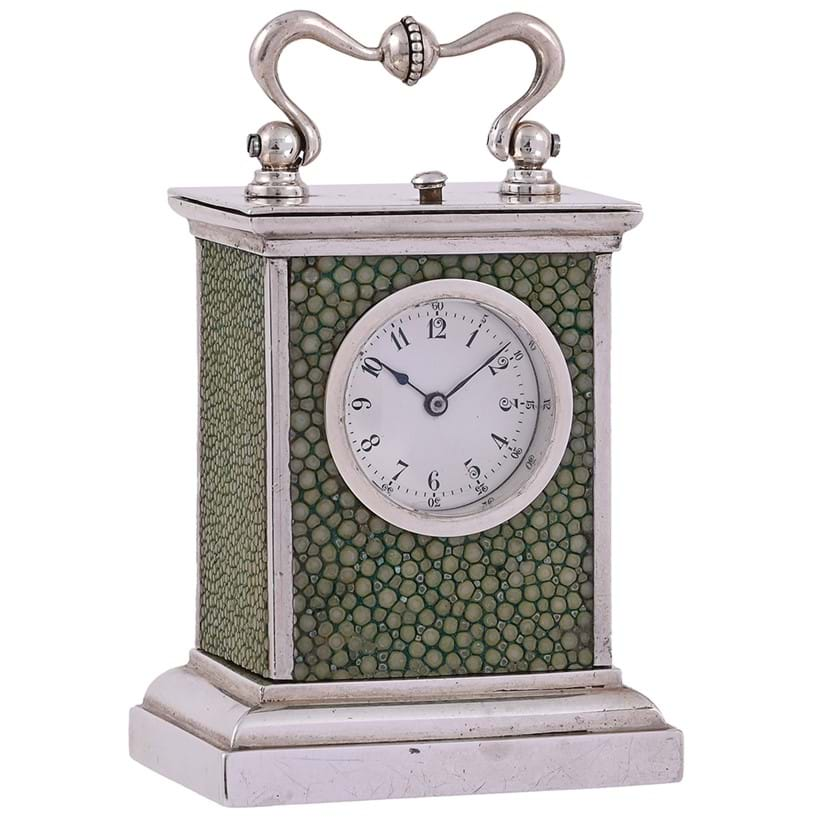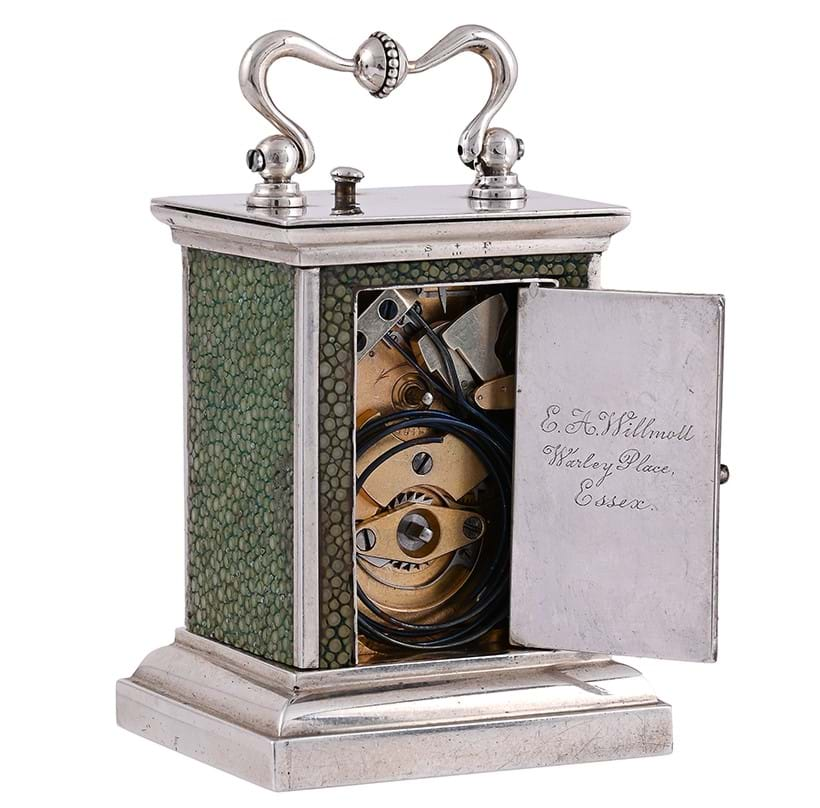Carriage clock owned by one of the most important British female horticulturists | Fine Clocks, Barometers and Scientific Instruments | 13 September
Coming up on Wednesday 13 September, we have our auction of Fine Clocks, Barometers and Scientific Instruments. Offered in the auction is a carriage clock owned by one of the most important British female horticulturists, also known as the gun-toting bad girl of the garden.
Lot 133, is a rare 1900 Swiss miniature silver carriage clock that was once owned by one of the most significant female horticulturists, plant researchers and plant photographers of the 19th and early 20th centuries. Ellen Ann Willmott (1858-1934), whose name inspired that of more than 200 plants (Veronica prostrata ‘Warley Blue’, Potentilla nepalensis ‘Miss Willmott’ and Syringa vulgaris ‘Miss Ellen Willmott’ to name a few), was awarded the first ever Victoria Medal of Honour to British horticulturists by the Royal Horticultural Society in 1897. Willmott was revered for her work in redeveloping the gardens of her family’s home Warley Place in Essex, made possible due to an inheritance from her aunt the Countess Helen Tasker (1823-1888). Her global plant-hunting expeditions to bring back and introduce new species into her gardens and her dedication to its design and diversity drew international recognition from world-renowned dignitaries and experts in the horticultural field. It also instigated frequent visits to the gardens from Royals, such as Queen Mary, Queen Alexandra and Princess Victoria.

However recent claims suggest that she was quite a notorious figure, she carried a loaded gun in her handbag and was described as being prickly in personality and eccentric in manner. Rumours circulated only recently that she sabotaged other people’s gardens by dropping seeds amongst their plants in order to impair their designs, but much of this is subject to an overripe imagination says biographer Sandra Lawrence, whose book Miss Willmott's 'Ghosts: The Extraordinary Life and Gardens of a Forgotten Genius' refutes this and delves further into Wilmott’s psyche.
Lawrence tells us that Wilmott set out to break the boundaries and restrictions imposed on women at the time and the gun toting was a defence mechanism, representative of her feelings of not being strong enough underneath, but displaying a tough exterior, in order to compete with her male counterparts. It gave her a sense of always being in control if she was ever to find herself in a vulnerable position. Wilmott persevered in joining academic societies usually only open to men, for example The Linnean Society, which was devoted to natural history, had a ban on women but Wilmott persuaded them to let her join.

When she didn’t collect her prestigious Victoria Medal of Honour as one of only two women out of 60 participants to have been awarded it, there much shock and disdain, which was put down to her ambivalence. However Sandra Lawrence reveals a letter that would change the slant on this apparent act of defiance. After Wilmott’s death in 1934 her belongings were sent to her sister Rose who had married into the Berkeley family and moved to Spetchley Park, Worcestershire. The items, which also included a 100 year-old chocolate bar had remained in a basement for many years until the house’s contents went up for auction. The letter reveals a love story between Wilmott and a Miss Georgina Tufnell, a lady in waiting to Princess Mary Adelaide. The letter suggests that they were in a relationship, however on the Princess’ death, Tufnell was to be made destitute and due to this accepted a marriage proposal from the elderly, very wealthy Lord George Mount Stephen and they were to be married the day after the award ceremony. With this in mind Wilmott retreated to her house in France broken-hearted.
She returned to continue her work in the gardens of Warley House and produced two books titled Warley Garden in Spring and Summer 1909 and The Genus Rosa in two volumes 1910-14. She won further accolades for the gardens in her French and Italian properties, such as the ‘Grand Medaille Geoffroi St. Helaire’ from the Société d’acclimation de France and the ‘Hean Hole medal’ from the National Rose Society. However by the 1920’s she became more reclusive and erratic and as her finances dwindled she was forced to sell her French and Italian properties. She sadly died alone in 1934.
Commenting on this extraordinary timepiece Leighton Gillibrand, Head of Dreweatts Clocks, Barometers and Scientific Instruments department, said: “This exquisite little timepiece would have been the perfect companion for a sophisticated traveller and clearly reflects Ellen Willmott’s refined taste. In addition to having a wonderful provenance this clock is also presented in lovely condition.”
The clock being offered for sale is thought to have been left by Wilmott at Spetchley Park when she was helping her sister with the extensive gardens there. It bears the inscription E. A. Willmott, Warley Place, Essex to its inside surface. It belongs to a varied series of ‘montre pendulette de voyage’ carriage clocks and timepieces made in Les Ponts-de-Martel, Neuchatel, Switzerland by makers such as Mathay-Tissot, during the late 19th century until the late 1920’s. Most of these were either sub-miniature, or mignonette sized. ‘Mignonette’ translates as ‘little darling’, with the standard French models coming in three differing heights; at 3.5 inches (with handle up), the size of the present clock sits between mignonette No. 2 and No. 3. The clock is highly decorative with shagreen panels which have an almost leather-like softness that features delicate dappled patterning, which contrasts strikingly against the silver. It is estimated to fetch between £1,200-£1,800 when it goes under the hammer in our Fine Clocks, Barometers and Scientific Instruments sale on September 13th, 2023.
Page Turning Catalogue
Auction Details
Wednesday 13 September, 10.30am BST
Donnington Priory, Newbury, Berkshire RG14 2JE
Browse the auction
Sign up to email alerts
VIEWING:
- Sunday 10 September: 10am - 3pm
- Monday 11 September: 10am - 4pm
- Tuesday 12 September: 10am - 4pm
- Wednesday 13 September: from 8.30am















